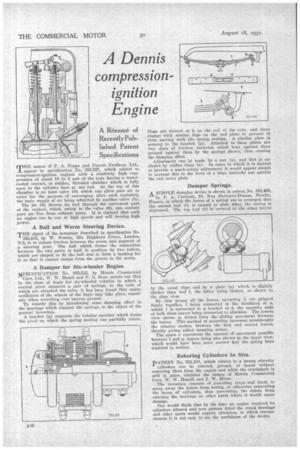A Dennis
Page 60

If you've noticed an error in this article please click here to report it so we can fix it.
compression
ignition Engine
A Resume of Recently Published Patent Specifications
THE names of P. A. Poppe a»d Dennis Brothers, Ltd., .appear in specification' No. 352,227, Which relates to compression-ignition engines with a relativelyhigh compression of shone 16 to 1 and of the 'type. having a watercooled venturi, or similar, throated chamber which is fully open to the cylinder bore at one end. At the top of this chamber is an inlet valve (9) which can allow pure air to enter for the purpose -of scavenging after each explosion, the mainsupply of air being admitted by another valve (5).
The jet .(6) directs its fuel through the narrowest 'part of the venturi, which, 'owing to the valve (9), can contain pure air free from exhaust gases. I.t is claimed that such an engine can be run at high speeds and will develop high
A Ball and Worm Steering Device.
THE object of the invention described in specification No. 352,415, by W. Fowler, 62a Highbury Grove, London, N.5, is to reduce friction between the worm and segment of a steering gear. The ball which forms the connection between the two parts is held in position by two rollers, which are shaped to fit the ball and to form a backing for it so that it cannot escape from the groove in the worm.
A Damper for Six-wheeler Bogies.
SPECIFICATION No. 352,515, by Morris Commercial Cars, Ltd., W. W. Hamil and P. G. Rose, points out that in the class of bogie for six-wheeled vehicles in which a central pivot supports a pair tif springs, to the ends of which are attached the axles, it has been found that undue oscillation of the wheels of the bogie may take place, especially when travelling over uneven ground.
To remedy this by introducing some damping effect in the bearings which support the springs, is the object of the present invention..
A bracket (g) supports the tubular member which forms the pivot on which the spring seating can partially rotate. Dogs are formed at h on the end of the tube, and these engage with similar dogs on the end plate to prevent it from moving, with the spring sealing. A similar plate is secured to the. bracket (g). Attached to these plates are two discs of friction material, which bear against discs pressed against them 'by_ the springs shown, thus causing the damping effect.
Adjustment can be made by a nut (s), and dirt is exeluded by ribber rings (n). In cases in 'which it is desired to provide a quick-acting adjustment it would appear simple to arrange this in the form of a lane butterfly nut outside the end cover plate.
Damper springs.
A SPIPLD damping device is shown in patent No. 352,495, by P. A. Carteret, 16, Rue ,Berteaux-Dumas, Neuilly, France, in which the leaves of a spring. are so arranged that the second Jest (f) is caused to slide when the spring is depressed. The top leaf (1) is 'secured to the. other leaves
by the usual clips and by a plate (g) which is slightly thicker than leaf f, the latter being slotted, as shown in the plan view.
By this means all the leaves, excepting f, are gripped firmly together, 1 being connected to the dumbiron at a, whilst f is connected to a bracket at d, the opposite ends of both these leaves being connected to shackles. The lowest view shows in dotted lines the sliding movement between the leaves. This method of mounting increases considerably the relative 'motion between the first and second leaves, thereby giving added damping action.
The space e' represents the amount of movement possible between f and g, spaces being also shewn in the upper view, which would have been more correct had the spring been depicted in section.
Reboring Cylinders In Situ.
PATENT No. 351,181, which relates to a means whereby
cylinders can be rebored, ground, or honed without removing them from the engine and while the crankshaft is still in place, contains the names of Morris Commercial Cars, W. W. Hamill and J. W. Meese.
The invention consists of providing traysand ducts to carry awaythe debris from boring, or otherwise renovating the bores of cylinders, thus preventing the debris from entering the bearings or other parts where it would cause damage.
One would think that by the time an engine required its cylinders rebored and new, pistons fitted the crank bearings and other parts would require attention, in which circumstances it is not easy to see the usefulness of the device.




























































































